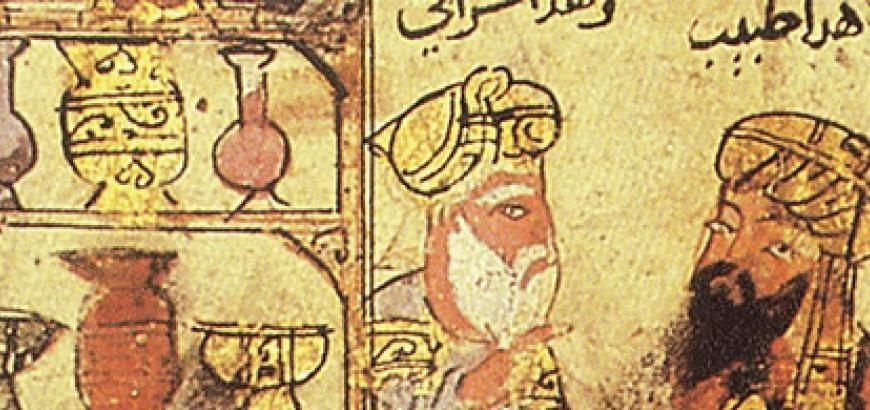The celebrated Middle English poet Geoffrey Chaucer describes a fanciful dialogue between Plato and one of his students, an exchange (addressing various subjects in physics) in which the two discuss the four elements and, among other concerns, a mysterious and powerful alchemical stone called “Titanos.” At one point, the student cites an equally obscure “book [of] Senior” as his main “witnesse” to the Platonic exchange. The fictional storyteller who is holding forth at this point in the Canterbury Tales, known as the Canon’s Yeoman, is an associate of a sort of religious careerist (the “Canon”), an unscrupulous priest who is eventually revealed to be a secretive alchemist. In a recent collaboration,Darius Klein (MA, Comparative Literature, 2013), in consultation with Professor Paul G. Remley (Department of English), has prepared the first complete English translation of the earliest version of the alchemical text (the “book [of] Senior”) cited by Chaucer. That source, known as Letter of the Sun to the Crescent Moon, was composed in Arabic not long before the year 1000 by an innovative and prolific mystical thinker, Muhammad Ibn Umail, whose important body of work is rapidly coming to be recognized more widely in scholarly circles.
Chaucer’s reference to a work by “Senior” alludes to a Latin alchemical text circulating in the later Middle Ages, based ultimately on the work of Ibn Umail, a treatise attributed in European circles to the authorship of a certain Senior Zadith Filius Hamuelis. The last two elements of this name comprise the common Latin term “filius” (or “son [of],” paralleling Arabic “Ibn”) and the form “Hamuel-” (going back to “Umail”); the honorific “Senior Zadith” approximates to “truthful sheikh.” The alchemical treatise known in the medieval period (as cited by Chaucer), which sadly remains the only work linked to Ibn Umail that has been discussed widely in modern scholarship, however, offered an abbreviated and in many ways defective Latin rendering of the original Arabic language of Ibn Umail. This is the state of affairs that the translation of the original Arabic text, by Darius Klein, and a study of the legacy of Ibn Umail, chiefly by Remley, hope to improve.
Muhammad Ibn Umail himself is emerging as one of the more engaging (and unduly neglected) figures of the early Middle Ages, a thinker who was, in some respects, centuries—or even a full millennium—ahead of his time. In other ways, Ibn Umail’s intellectual perspectives remain utterly unique even to the present day, reflecting an idiosyncratic approach to mysticism that is situated essentially outside of time and space altogether. As early as the 1940s, the psychoanalytic pioneer C. G. Jung credited Ibn Umail with innovating the use of true archetypal symbols, where otherwise mundane imagery of chameleons and frogs in Letter of the Sun to the Crescent Moon, for example, ultimately tap into subconscious precursors. Moving far beyond pedestrian medieval uses of metaphor and allegory, Ibn Umail anticipated significant aspects of contemporary psychology and gender studies as well, as in his approaches to eroticism and the containment of desire, his transcendence of conventional dichotomies of “female’ and “male” principles, and so on. In relation to other great thinkers emerging out of Islamic scholarly traditions, Ibn Umail reveals no clear affinity either with the theology of Shia or with distinctive Sunni doctrines, but he is sometimes linked to early Islamic Isma’ili doctrine, noted for its symbolic interpretations and esotericism.
It is not known where Ibn Umail lived or even what nationality might be assigned to him reliably. He describes (in stunning detail) two visits that he made to a pharaonic temple in Egypt, and he is sometimes thought to have been an Egyptian; but these visits may have occurred in the course of his foreign travels. Manuscripts of Ibn Umail’s works circulated extensively in western Asia, and his writings may reveal affinities with alchemical traditions connected with regions of modern Iran and India. There are also indications that he may have lived in a Mesopotamian region, perhaps in an area of the northern Iraq.
Even today, at least four major works by Ibn Umail remain wholly unedited and, indeed, unavailable in any form beyond the very few surviving copies in manuscript. At present, there is an intensive effort under way in post-Jungian circles, centering on Zurich, to edit unpublished Arabic texts of works by Ibn Umail, with facing-page translations in modern English, in the series Corpus Alchemicum Arabicum. The irony here is that Ibn Umail’s masterwork, Letter of the Sun to the Crescent Moon, appeared in an adequate scholarly edition in 1933, and thus its appearance in the new series, where it would acquire an authoritative English translation, has been delayed so that what were considered more urgent projects might be completed first. The collaboration undertaken by Darius Klein and Paul Remley thus helps to address an immediate necessity and, with its review of recent scholarshiop, stands to provide a basis for future research.

